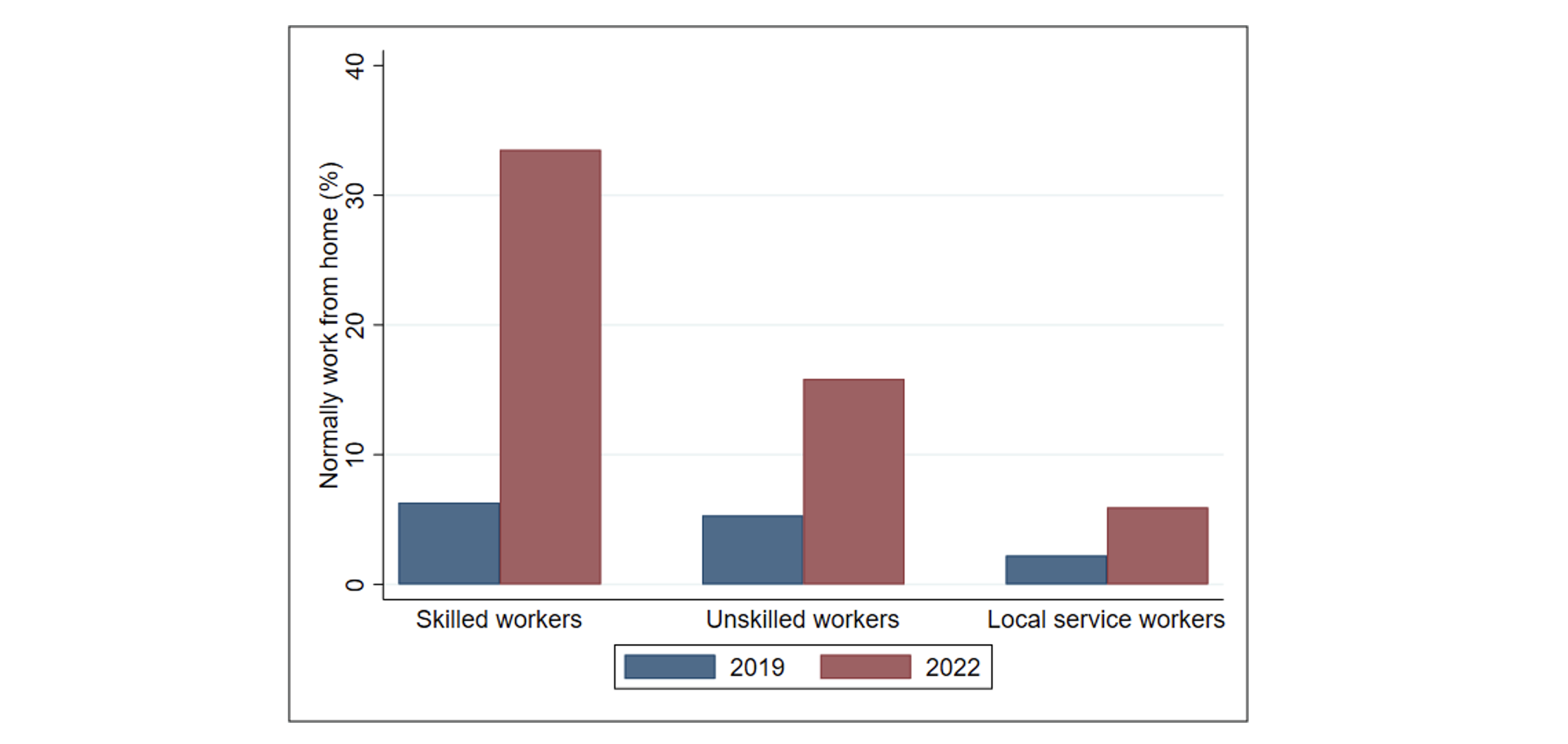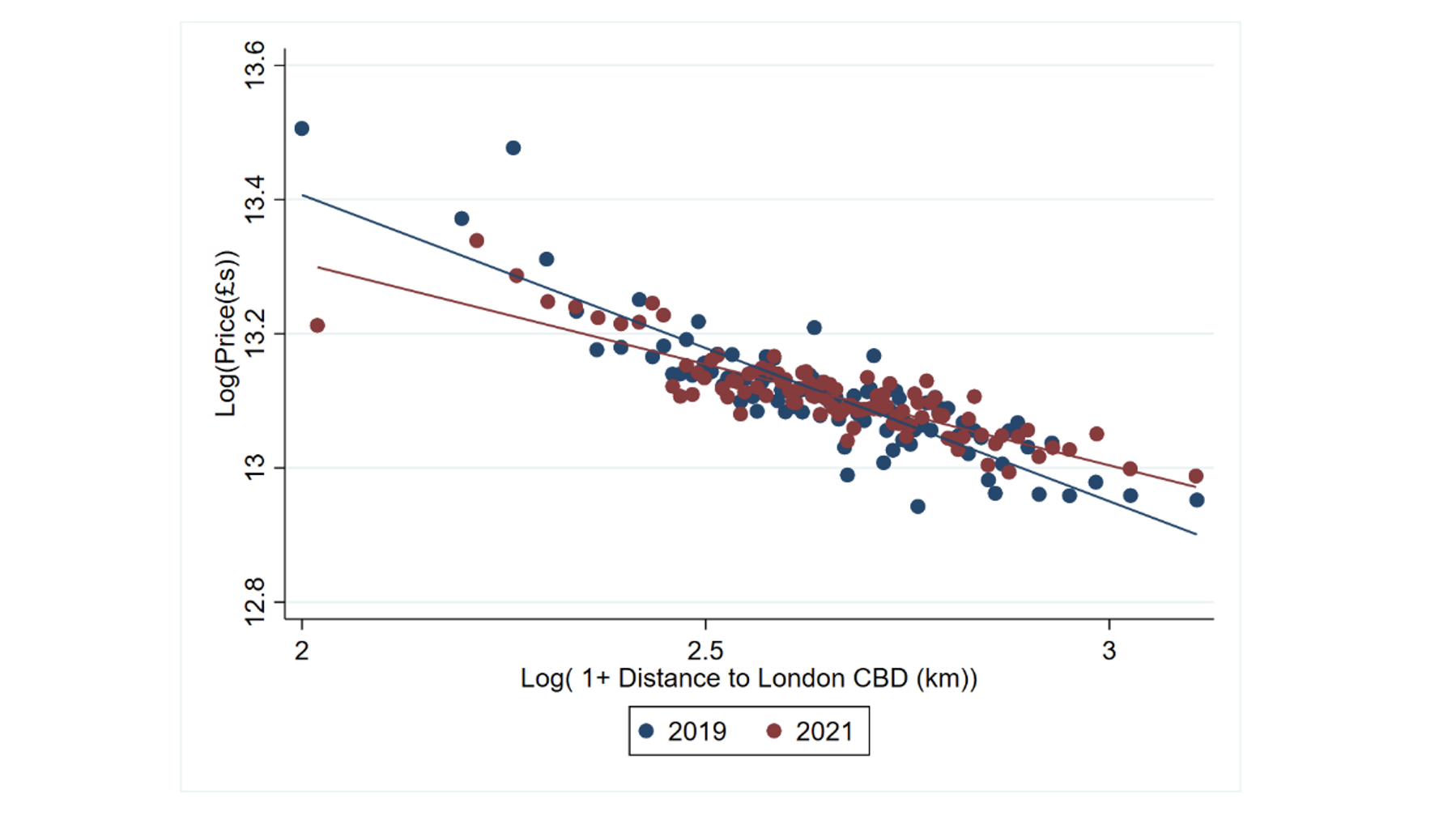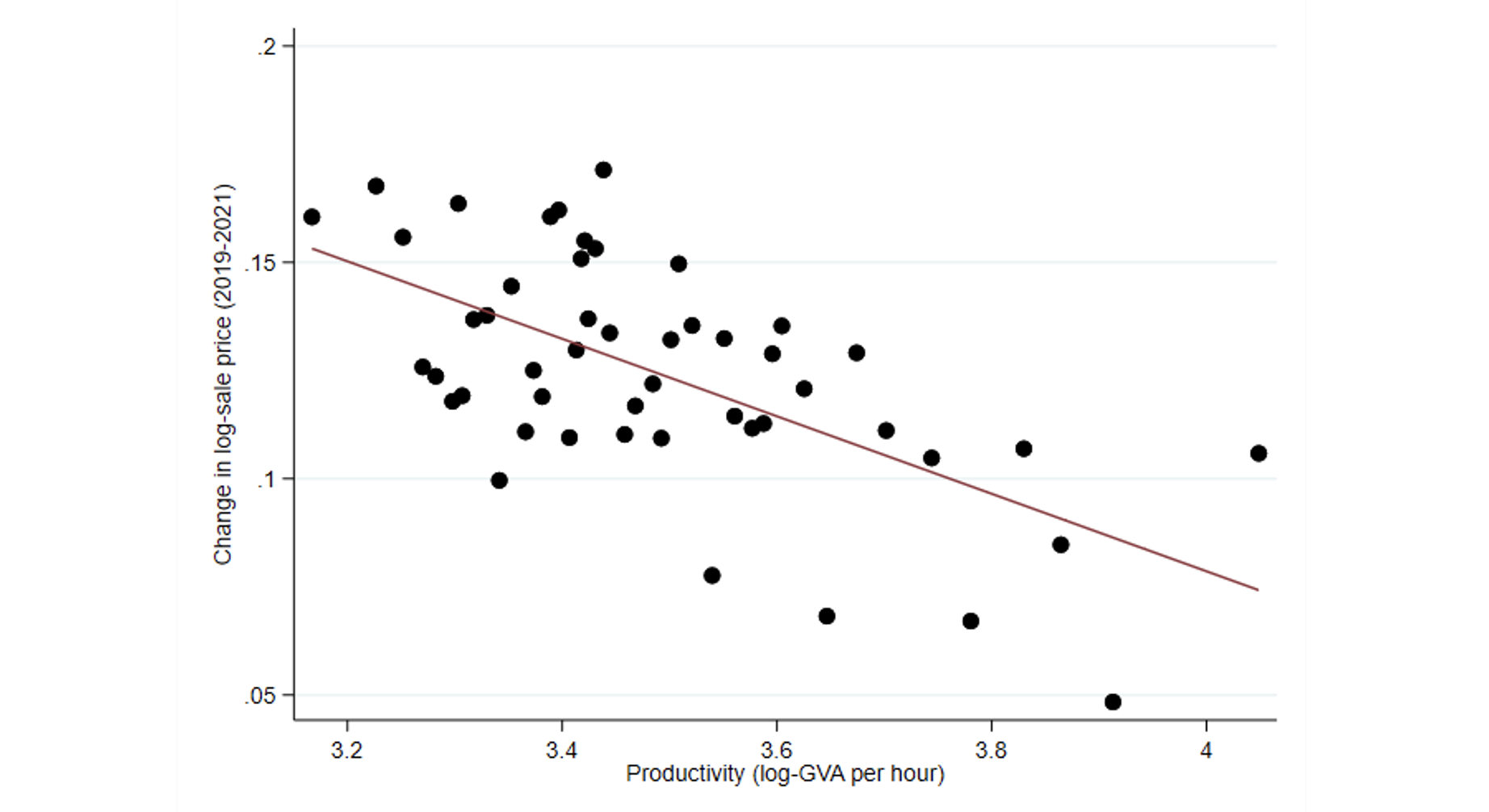More than two years after the start of the Covid-19 pandemic, many areas of life are returning to the pre-pandemic normal. But the shift towards a larger proportion of work being done away from the office appears to be truly becoming a new normal. Recent survey evidence indicates that the increased amount of work done from home is here to stay (Zarate et al. 2022).
However, the shift to teleworking has not been evenly realised across the labour force. In the UK, Labour Force Survey estimates show a dramatic 24 percentage point (400%) increase in teleworking for skilled workers, but more modest increases for unskilled workers (Figure 1). This is consistent with previous studies documenting unskilled occupations – particularly those in the local services industry (restaurants, cafés, haircuts) – that must be done onsite (Dingle and Neiman 2020, Adams-Prassl et al. 2022).
Figure 1 Working from home in the UK, 2019 versus 2022
Note: Proportion of employed survey respondents who state they normally work for home in their main job. Covers January to May of 2019 and 2022.
Source: Authors calculations from UK Labour Force Survey.
There is building anecdotal evidence that this rise in teleworking is requiring major cities to adapt. San Francisco has struggled to bring workers back to city-centre offices (Holder 2022). There are reports that London is experiencing an exodus of high-skilled workers seeking less expensive housing and better lifestyles in residential-friendly towns and cities (Sidders 2022). This coincides with the closure of up to 14% of central London restaurants since 2020 (Barns 2022), and similar stories across other major cities including Manhattan, Toronto, and Paris.
How will the rise in teleworking impact our cities? Will these changes affect labour market opportunities and urban inequality? What might happen if teleworking continues to rise?
The structure of residential neighbourhoods
In a new paper (Gokan et al. 2022), we examine how an increase in the intensity of teleworking affects the labour market and residential organisation of cities. To do this, we propose a general equilibrium model of a monocentric city, with low-skilled workers, high-skilled workers, and teleworking. Consistent with empirical evidence, high-skilled workers can telework or work onsite in the central business district (CBD). Low-skilled workers only work onsite, but can choose to work in the production of final goods (e.g. manufacturing) or providing locally consumed services (restaurants, cafés, haircuts) to workers in the CBD.
Workers choose where to live and, when working onsite, must pay to commute into work. At low (pre-pandemic) levels of teleworking, cities will be gentrified in the sense that high-wage skilled workers will live close to the city centre, while lower-wage unskilled workers occupy suburbs around the periphery. This results in a large premium on housing located closer to the CBD, as skilled workers bid up prices. However, as the amount of teleworking skilled workers increases, their commuting decreases, which decreases the amount they are willing to pay to live close to the CBD. Therefore, increased teleworking leads to a decrease in central housing relative to suburban housing.
This prediction is consistent with the behaviour of housing prices since 2019. In London, the premium paid for having a home closer to the CBD has fallen by 17.1 percentage points. In 2019, moving 10% closer to the CBD meant spending 4.6% more on housing; in 2021 this premium fell to 2.91%. Figure 2 illustrates the flattening of the relationship between housing prices and distance to central London. The agreement with our model is not unique to London; similar evidence is found for cities in the US and China (Gupta et al. 2022, Brueckner et al. 2021, Huang et al. 2022).
Figure 2 Distance to central London and property sale prices, 2019 versus 2021
Source: Gokan et al. (2022).
This can lead to a fundamental change in the structure of the city. When the proportion of teleworking becomes sufficiently large, our gentrified city turns into a doughnut city, as skilled workers abandon their central homes in search of more affordable suburban options. The unskilled workers, still doing all work onsite, relocate to the central neighbourhoods.
The labour market for unskilled workers
The rise of teleworking among skilled workers has important implications for unskilled workers.
First, because skilled workers spend less time in the CBD, they consume fewer of the local services provided by unskilled workers (consistent with analysis by Barrero et al. 2021, Timms et al. 2021, and Taneja et al. 2022). This leads to a destruction of jobs in the local services industry, forcing unskilled workers to move into the manufacturing sector. This decreases wages for unskilled workers but increases wages for skilled workers. Thus, the increase in teleworking will exacerbate urban wage inequalities. However, this effect may be attenuated if skilled workers consider the flexibility associated with teleworking as an amenity and are willing to accept hybrid jobs at a lower wage (Barrero et al. 2022).
Second, teleworking also affects unskilled workers through the cost of urban living. When teleworking is sufficiently high to create a doughnut city, unskilled workers who do not live centrally benefit from lower commuting costs than in a gentrified city. However, this benefit is offset by an increase in housing costs for unskilled workers. Therefore, the net effect on urban costs is ambiguous.
Between city commuting
These changes will not be limited to a movement of workers within the city, but will also reallocate workers across cities. Teleworking allows skilled workers to reside in locations with affordable housing, and perhaps better lifestyles, while retaining well-paid jobs in high productivity, expensive cities. Expanding our model, we show that this is exactly the pattern we expect. When teleworking increases, skilled workers become between-city commuters, seeking affordable housing in a low-productivity city while retaining employment in a high-productivity city.
This has an interesting consequence for the low-productivity city. The city becomes gentrified, as skilled workers increase the average wages of residents. But this does not benefit the local services industry, as there are no skilled jobs created in the CBD. In this way, teleworking differs from standard models of inter-city migration, as jobs and residents do not move in tandem.
A key prediction of this model is that as teleworking increases, we expect to see housing prices rise more in lower productivity (lower cost) cities than in high productivity (high cost) cities. We test this by looking at the growth in residential property prices for cities across England and Wales between 2019 and 2021. The evidence is consistent with the model: higher productivity cities saw lower growth in their housing prices (Figure 3). This relationship is stronger in cities that had a higher proportion of residents in jobs that could potentially be done from home before the pandemic.
Figure 3 Growth in housing prices and productivity for UK cities, 2019–2021
Source: Gokan et al. (2022).
This parallels the effect of improving between-city commuting infrastructure. For example, Loumeau and Russo (2022) show that the 2017 expansion of the French high-speed rail network from Paris to Rennes and Bordeaux induced Parisian skilled workers to move to these cities, where they disproportionately occupy central locations. Housing prices in these cities have increased by 7%.
Conclusion
The consequences of teleworking go way beyond productivity gains or losses for firms and workers. Teleworking affects unskilled workers who do not work from home, the social structure of cities, and the cost of housing. The permanent increase in teleworking will require strategies to ensure that the renewal of urban centres observed in many big cities is not reversed. These changes are likely to exacerbate urban inequalities, and have a disproportionately negative effect on workers providing local services.
Inter-city commuting is likely to have an impact on cities’ finances. Fewer commuters – or workers who commute less often – could significantly decrease the demand for office space (Henricot at al. 2022, Mittal at al. 2022) and translate into a shrinking local revenue base (Agawal and Stark 2022).
References
Adams-Prassl, A, T Boneva, M Golin and C Rauh (2020), “Work that can be done from home: Evidence on variation within and across occupations and industries”, Labour Economics 74: 102083.
Agrawal, D R and K J Stark (2022), “Will the remote work revolution undermine progressive state income taxes?”, CESifo Working Paper 9805.
Barns, O (2022), “City of London has lost 14% of its restaurants since 2020”, Financial Times, 14 August.
Barrero, J M, N Bloom and S Davis (2021), “Why working from home will stick”, NBER working paper 28731.
Barrero, J M, N Bloom, S J Davis, B Meyer and E Mihaylov (2022), “The shift to remote work lessens wage-growth pressures”, NBER Working Paper 30197.
Brueckner, J, M Kahn and G C Lin (2021), “A new spatial hedonic equilibrium in the emerging work from home economy?”, American Economic Journal: Applied Economics, forthcoming.
Dingel, J and B Neiman (2020), “How many jobs can be done at home?”, Journal of Public Economics 189: 104235.
Gokan, T, S Kichko, J Matheson and J F Thisse (2022), “How the rise of teleworking will reshape labor markets and cities”, CEPR Discussion Paper 17672.
Gupta, A, V Mittal, J Peeters and S Van Nieuwerburgh (2022), “Flattening the curve: Pandemic-Induced revaluation of urban real estate”, Journal of Financial Economics 146(2): 594–636.
Henricot, D, J B Eymeoud, T Garcia and A Bergeaud (2022), “Working from home and corporate real estate”, VoxEU.org, 17 January.
Holder, S (2022), “Inside Downtown San Francisco’s Plan to Reinvent Itself”, Bloomberg UK, 2 August.
Huang, N, J Pang and Y Yang (2022), “COVID-19 and household preference for urban density in China”, Journal of Urban Economics, forthcoming.
Loumeau, G and A Russo (2022), “Second-hand gentrification: Theory and evidence from high-speed rail extensions”, CESifo Working Paper 9992.
Mittal, V, S Van Nieuwerburgh and A Gupta (2022), “Work from home and the office real estate apocalypse”, VoxEU.org, 2 November.
Sidders, J (2022), “Londoners Leaving the City in Droves as Covid Trend Persists”, Bloomberg UK, 1 August.
Taneja, S, J Rockey, J Matheson, P Mizen and G De Fraja (2022), “Remote working and the new geography of local service spending”, VoxEU.org, 17 November.
Timms, D, J Matheson, J Rockey, G De Fraja (2021), “The geography of working from home and the implications for the service industry”, VoxEU.org, 11 February.
Zarate, P, M Dolls, S Davis, N Bloom, J M Barrero, C G Aksoy (2022), “Working from home around the world”, VoxEU.org, 8 October.










